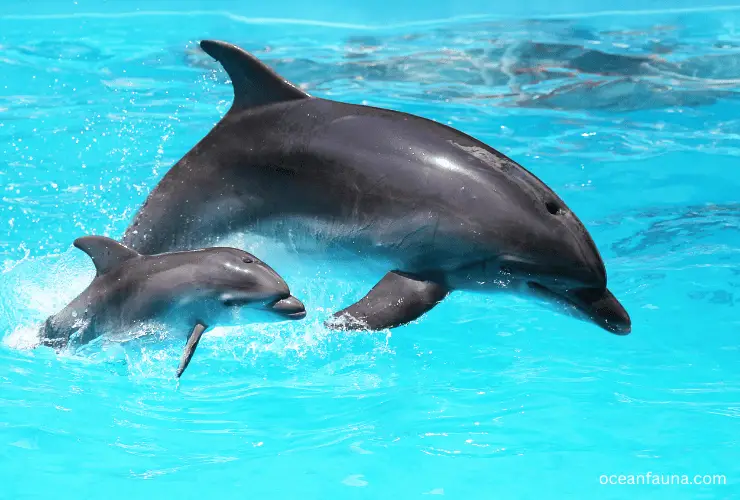Dolphins are known to be friendly marine mammals. While it’s true that deadly ocean predators like many small sharks are often afraid of dolphins, they (dolphins) are also preyed upon by other predators.
What are dolphins’ predators?
Dolphins are mainly preyed upon by large shark species such as Great White Sharks, Tiger Sharks, Bull Sharks, and Dusky Sharks. Also, Orcas, which belong to the dolphin family, are known to prey on dolphins. Even humans are considered dolphins’ predators in some areas of the world.
In this article, I will discuss these dolphins’ predators in detail.
Do Dolphins Have Predators?
Yes, dolphins do have predators. They are not at the top of the food chain and face various threats in their natural habitats. Sharks and orcas are known to prey on dolphins, especially in areas where their populations overlap. Orcas, also known as killer whales, are particularly skilled hunters and have been observed targeting dolphins in coordinated attacks.
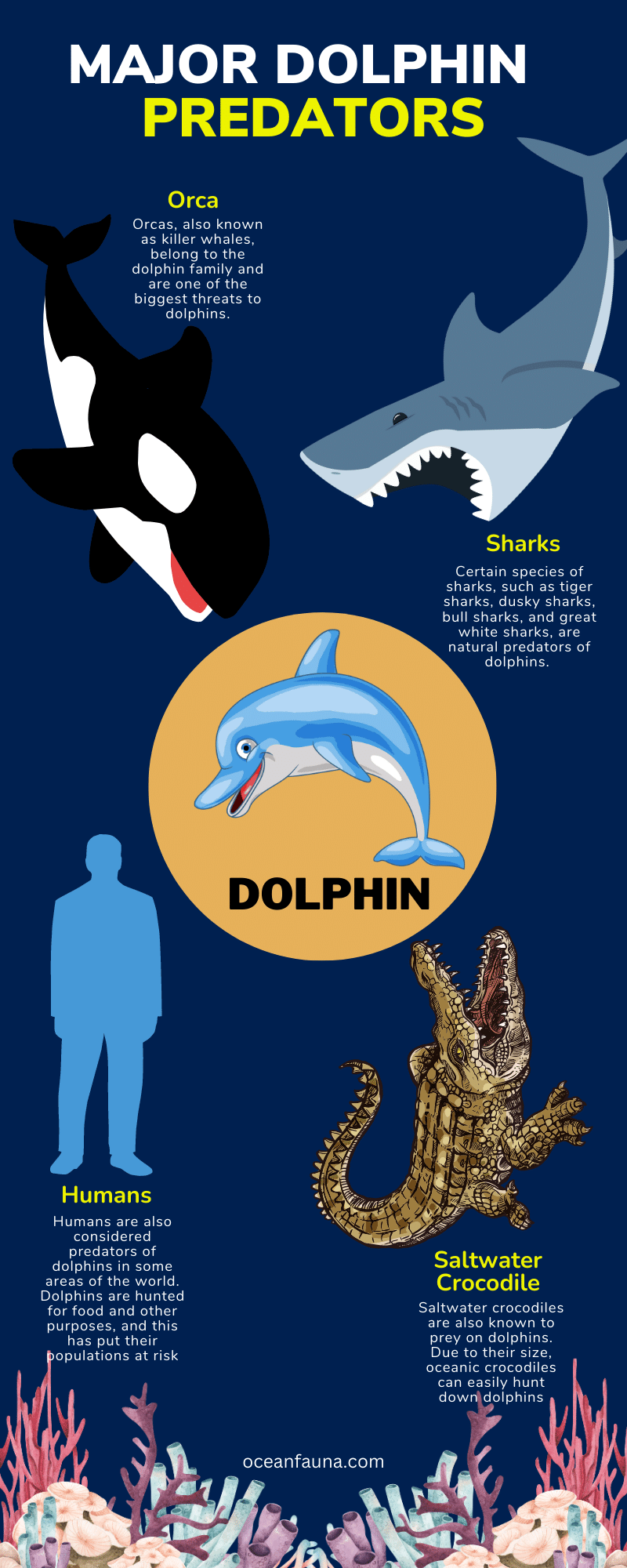
Apart from being hunted, dolphins face other threats as well. They can get entangled in fishing gear, which can lead to drowning, injury, or death. In addition, human activities such as pollution, habitat destruction, and climate change can also harm dolphin populations.
Despite their intelligence and social behaviours, humans still hunt dolphins in some parts of the world. This is often due to cultural traditions or the demand for meat or other products made from dolphin parts.
Some dolphin populations are more threatened than others. Certain species or populations may face more predators or threats due to location, habitat, or behaviour. Conservation efforts are crucial to protect dolphin populations and prevent their decline.
What Are Dolphins’ Predators?
Dolphins are apex predators and are known for being at the top of the food chain. However, they do have their own set of predators that they need to watch out for, and these are discussed below.
Shark species
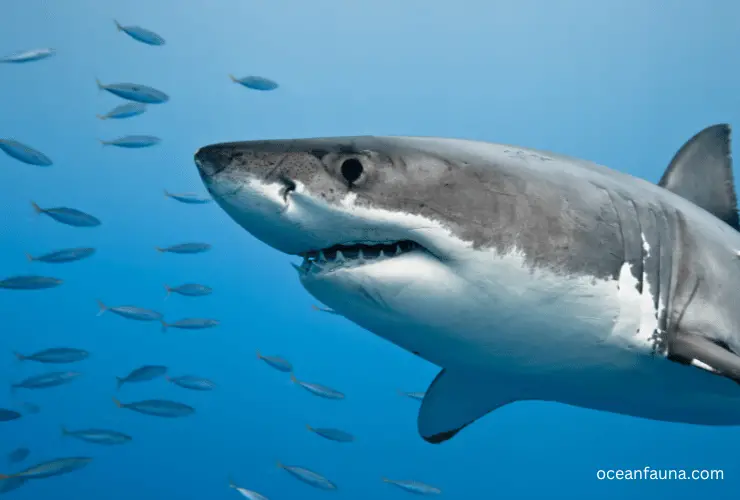
Certain species of sharks, such as tiger sharks, dusky sharks, bull sharks, and great white sharks, are natural predators of dolphins. These sharks are known to attack and kill dolphins for food or when they feel threatened. In Sarasota Bay, Florida, around 31% of dolphins have shark bite scars, which clearly indicates how often they encounter these predators.
Orcas
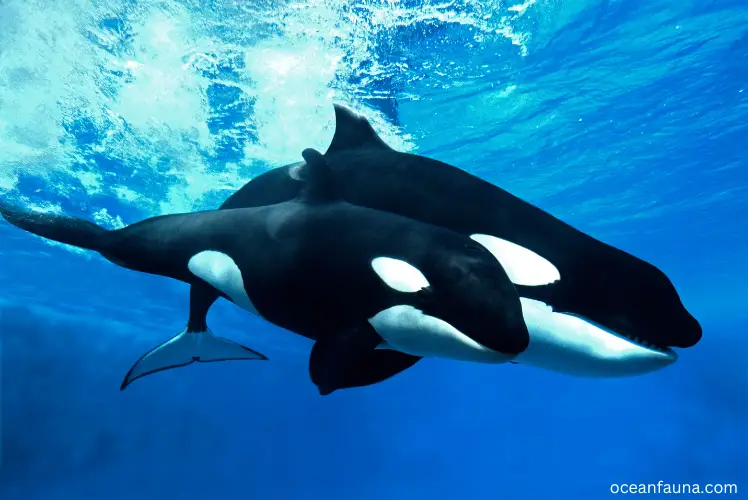
Orcas, also known as killer whales, belong to the dolphin family and are one of the biggest threats to dolphins. They are known to prey on dolphins as well as other marine mammals such as seals and sea lions. Orcas are highly intelligent and skilled hunters, which makes it difficult for dolphins to escape their attacks.
Saltwater Crocodile
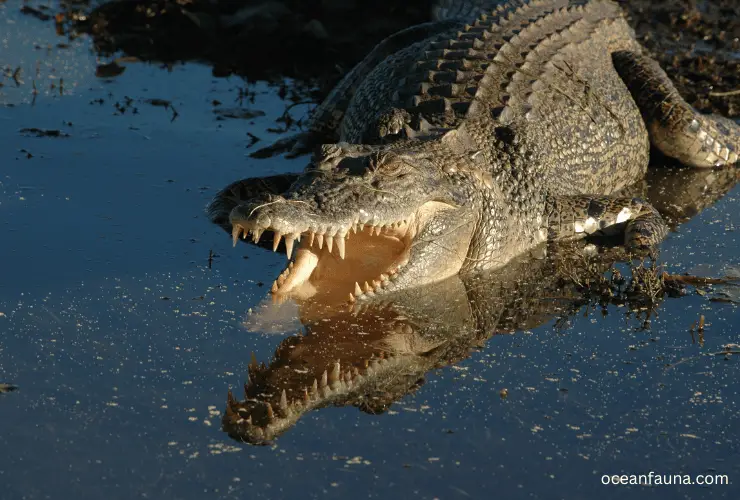
Saltwater crocodiles are also known to prey on dolphins. Due to their size, oceanic crocodiles can easily hunt down dolphins. These reptiles can grow up to 17 feet long and weigh more than 2000 pounds. They eat fish, turtles, birds, small mammals, and sometimes dolphins. However, dolphins working as a team can outsmart a crocodile.
Humans
Humans are also considered predators of dolphins in some areas of the world. Dolphins are hunted for food and other purposes, and this has put their populations at risk. In some parts of Asia, dolphins are killed for their meat, while in other parts of the world, they are captured for entertainment purposes, such as dolphin shows.
In Japan and Peru, dolphins are hunted for meat and other products. This is a major conservation concern as it threatens the survival of some dolphin populations.
What Is the Biggest Killer of Dolphins?
The biggest killer of dolphins is none other than the human being. Dolphins and other water-dwelling wildlife, such as cetaceans, constantly face threats from humans. There are various ways in which humans impact the lives of these aquatic mammals, including hunting, fishing practices, water pollution, and plastic waste.
Firstly, the hunting of dolphins is a major threat to their population. In some countries, dolphins are hunted for meat, oil, and other products, despite being protected under international agreements. The hunting of dolphins not only decreases their population but also affects their social structure.
Secondly, fishing practices also harm dolphins. For instance, purse seine fishing, where large nets are used to catch large amounts of fish, often results in unintentional bycatch of dolphins. This technique has resulted in the death of thousands of dolphins each year. Additionally, trawl fishing, another type of fishing that drags large fishing nets across the ocean floor, negatively impacts dolphins and other marine life.
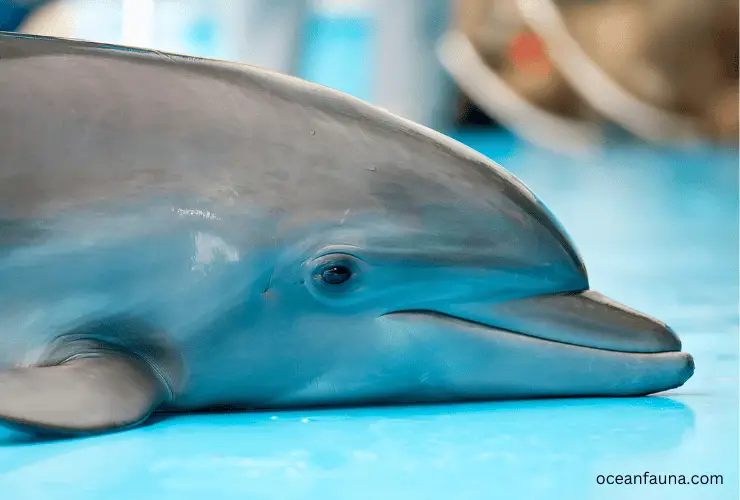
Thirdly, water pollution poses a great threat to dolphins. Human activities such as industrial and agricultural waste, oil spills, and sewage discharge harm dolphins by contaminating their water. The polluted materials can harm dolphins’ health and their prey, which can indirectly impact their population by creating food scarcity.
Lastly, plastic waste is also a major problem for dolphins and other marine life. The vast amount of plastic in the ocean moves with ocean currents and breaks down into smaller particles, which dolphins and other marine animals then ingest. Plastic ingestion can result in internal damage, which can lead to death.
Which Dolphin Is Most Preyed Upon?
Which dolphin species is preyed upon the most? The answer is the bottlenose dolphin, which has the highest number of predators compared to other species.
Bottlenose dolphins are found in oceans and other water bodies worldwide and are known for their intelligence and social behaviour. Unfortunately, due to their abundance and accessibility, bottlenose dolphins are targeted by a wide range of predators.
Some of the predators that prey on bottlenose dolphins include large sharks such as the tiger shark and great white shark, killer whales, and even crocodiles in certain parts of the world. In addition to these predators, bottlenose dolphins are also vulnerable to human activities such as fishing and pollution, which can impact their populations.
The fact that bottlenose dolphins have the most predators highlights the importance of understanding the threats facing this species and working to protect them. Conservation efforts are needed to address the dangers facing these intelligent and fascinating creatures and to ensure that they continue to thrive in the wild.
Are Dolphins Safe to Eat?
No, dolphins are not safe to eat, and their consumption can pose a serious health danger to humans. Dolphin meat is known to be high in mercury, a neurotoxin that can cause brain and nervous system damage when consumed in high amounts over time.
In fact, dolphins are one of the most mercury-contaminated marine species due to their position at the top of the food chain, where mercury bioaccumulates in their bodies.
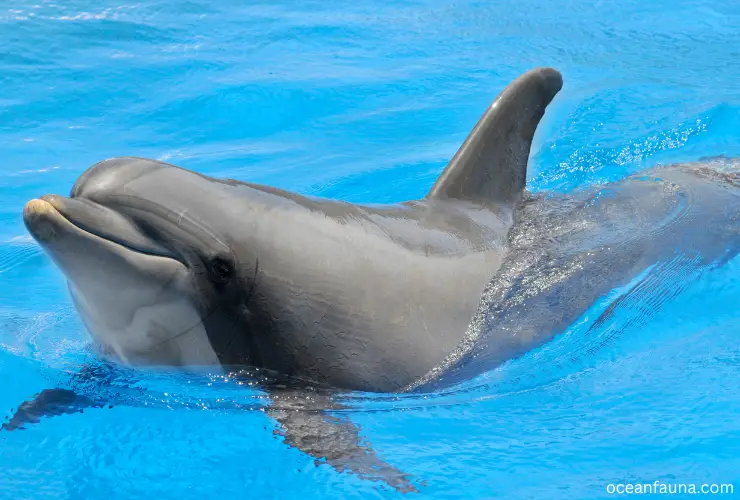
Mercury is a potent neurotoxin that can cause a range of health problems in humans, including tremors, memory loss, and developmental delays in children. It can also harm a developing fetus and lead to behavioural and learning problems in children.
Therefore, consuming dolphins and any marine species high in mercury should be avoided to prevent these health risks.
While dolphin meat has some nutritional benefits, such as being high in protein, these benefits do not outweigh the potential health risks associated with consuming it. Many countries, such as the United Kingdom, Peru and the United States, prohibit the killing and sale of dolphins for human consumption.
Do Dolphins Have Enemies?
Yes, dolphins do have enemies, and their main enemy is the shark. However, dolphins in groups are not afraid of sharks and will often torment and even kill solitary sharks.
Dolphins are incredibly agile and have muscular bodies that allow them to outmanoeuvre and confuse a shark. They will circle around the shark, making it dizzy and disoriented and ultimately making it easier to attack.
Additionally, dolphins are known to use their strong snouts to hit a shark’s gills or eyes, inflicting serious injuries.
Despite their ability to defend themselves against sharks, smaller dolphins can still fall prey to larger sharks when they are alone. These situations are more common for younger, less experienced dolphins who may not have the same level of agility or strength as their adult counterparts.
Are Dolphins Common Prey for Orcas?
Yes. Dolphins are common prey for orcas, although they are not their primary food source. Orcas are generalist eaters, meaning they are able to consume a wide variety of prey, including fish, sharks, seals, sea lions, and even other whales.
However, in some areas, dolphins are a common prey item for orcas, and some populations of orcas have even been observed specializing in hunting certain species of dolphins.
Despite being relatively small compared to other marine mammals that orcas hunt, dolphins are still an important part of their diet in some areas. It is thought that orcas are attracted to dolphins because they are highly social animals that travel in large groups, making them an easy target for the ocean’s apex predator.
Although orcas are known to hunt and eat dolphins, their impact on dolphin populations is poorly understood. It is possible that in areas where orcas are common, dolphin populations may be affected by predation.
Still, more research is needed to fully understand the relationship between orcas and dolphins.
Conclusion
You now have detailed information about the predators of dolphins. The list includes large sharks, orcas, saltwater crocodiles, and humans. However, based on research, humans are the main killer of dolphins.
Let me know if you want to know more about dolphins’ predators.

